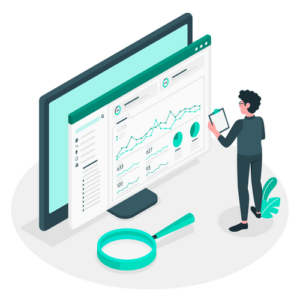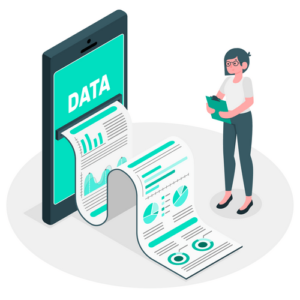The customer service industry has been changing to place the customer in the first place. Contact center data plays a significant part in this growth, and the most successful firms make the most of this technology. Contact centers audit and monitor every member of the team daily and even every encounter with a client. Big data for contact centers brings insights and business possibilities at every level of the organization if managed correctly.
That is why Call center analytics enables you to collect and analyze customer data to prioritize them. These reports also improve your call center and business intelligence by providing actionable data and metrics.
The Advantages of Call Center Analytics

Call canter analytics provides data such as call duration length, customer satisfaction, and the number of times a consumer contacted you to acquire a resolution. It can even employ voice analytics to obtain a better grasp of your customers’ annoyance. This is accomplished by tracking the different touchpoints a client has with the contact center, such as hold time, number of calls made, and other pertinent metrics from the self-service system. Metrics are then saved in your call center software’s database. The data is useful for assessing agent performance and improving customer engagement. And sorting through that data to uncover the components that can be used to drive change in your company can help your agents and supervisors perform better.
Aside from traditional call logs, Call Center Analytics solutions enable you to delve into existing customer data to extract metrics and make more informed business decisions throughout the customer journey.
- At no additional cost: The Call Center Analytics package that comes with the account assists you in managing all aspects of your customer relationship center operations. That means you won’t have to pay anything extra to use this powerful data analytics software.
- Extensive and adaptable data mining: You will receive a micro and macro analysis of all your data, as well as unique geographic information on call types and activity fluctuations. This comprehensive data includes information on every inbound and outbound call.
- Easy-to-use features: The Call Center Analytics platform was created with the end user in mind. The analysis reports require little training to comprehend. The dashboard view walks you through the analysis of graphs, logs, and reports that detail all of your calls.
- Extremely deployable and scalable: The analytics tools, like all of our call center solutions and voice service, are simple to implement in your organization. They can expand in tandem with your company, as well as with the addition of call centers and agents.
How analytics improve your contact center’s business intelligence
Increasing your contact center agility
Being a customer-centric contact center requires focusing the whole organization’s attention on the clients. Decisions based on this strategy are always made with the consumer in mind. And the goal of establishing a contact center is to have a dedicated group of people who can prioritize your customers’ needs and desires. However, if your call center agents are overburdened by high call volumes and low staffing levels, they will not perform effectively. This results in long hold times, lower resolution rates, and higher churn.
Using call center analytics, you can avoid this by anticipating when high call volumes are likely, such as during vacations or product launches. This allows you to respond quickly to changing demands while also having more staff to handle all incoming calls.
You can also use call center analytics to examine data from your customer interactions to identify gaps in your systems and processes. For example, if you notice that many of your customers are contacting your support teams through Facebook, you can adjust your staffing requirements accordingly. As a result, your call center team becomes more efficient and quickly adapts to your and your customers’ needs.
Assisting your teams in adhering to your strategy
Call center operations are frequently treated as distinct from other departments. As a result, the data collected from your call center and the data collected from your sales department, marketing teams, and product teams are frequently not combined and shared.
Because call center analytics connects all of the data sources, sharing information across teams is possible and simple. You learn how each department affects the others by making customer data available to all of your teams. You can also identify ways to improve your collaboration. This allows you to align strategies and goals in order to improve the customer experience and build stronger customer relationships.
For example, when your teams are promoting a product or a service during a specific campaign, you can share it with call center agents so that they can promote it in both inbound and outbound calls. And, if previous experience has shown that the promotion will increase call volume, you can staff your call center accordingly.
As a result, your overall business intelligence capabilities improve, and team operations are optimized.
Promoting objective decision-making
Putting your trust in your gut leads to poor business decisions. Intuition will not tell you how to optimize your call center operations or meet your key performance indicators. In addition, they will not tell you why one business decision is superior to another.
Analytics in call centers, on the other hand, fosters a data-driven culture. Data analytics in call centers makes information accessible and available to everyone in your organization. For example, call center managers can evaluate agent productivity to see where agents are falling behind and where they are excelling. They can also see how a particular decision affects call times, conversion rates, and handle times.
Furthermore, because call center analytics makes performance measurable, you can use targeted coaching to improve each agent’s skills and award performance-based bonuses. Data analytics can also be used in the hiring process. To find the best talent, you can focus on the performance metrics that your support agents or sales reps share when recruiting.
Increase your sales conversion rates
A good analytics tool should not only improve the efficiency and productivity of your call center but it should also look for ways to increase revenue on a proactive basis. It accomplishes this by predicting what customers might be interested in in the future based on behavioral profiles, demographics, and purchase history. As a result, your sales teams can recommend that product to customers or notify them when there is a special promotion on that product.
Another option is to assist you in determining the most effective outbound call strategies. For example, calling prospects in the afternoon may result in higher conversion rates than calling in the morning. Based on the types of sales techniques that have worked best in the past, analytics can also teach your reps how to better phrase questions or tailor their pitch to get customers to buy.
Enhancing agent performance
As previously stated, call center analytics tools do more than just collect customer data. They can also assist you in analyzing the performance of your agents. Analytics reports can show you where an agent excels and where they may require additional assistance. They also enable you to objectively identify the best-performing agents using key performance indicators (KPIs) such as wait times and first call resolution rates for support agents or closing rates and deal value for sales representatives.
By identifying the KPIs that correspond to your business objectives, you can find the best ways to structure your call center operations and teams for optimal results.
For example, NobelBiz Omni+ is a CCaaS solution that can identify inefficiencies and time-consuming tasks and measure agent performance.
How to harness Data: The 3 V’s

No organization wants Big Data to contaminate its transactional database. However, the demand for information is such that they must obtain data fast and do real-time analysis to respond to shifting patterns. And there is a common framework with three key points for managing and understanding Customer Data. Volume, Velocity, and Variety, which are the three V’s of data.
“Paying attention to data management, particularly in a climate of e-commerce and an increased need for collaboration, can enable companies to get more value out of their information assets,” explained Doug Laney of Gartner, who invented the terms.
The three Vs may be the key to successfully leveraging Data in any contact center.
Volume
Logs, screen recordings, voice recordings, CRM entries, KPIs, social media, and other data are all retrieved and stored in a contact center. This is a massive amount of data, and IT processes must sort through it all and distill what is essential. Large amounts of data in contact centers are critical to ensuring that the dataset is complete and relevant enough to provide a complete picture of its business.
Varities
Large amounts of data retrieved from various sources naturally result in a great deal of variety with many different formats. Because of the variety of aspects of data, processing that large amount is technically challenging. It varies significantly from application to application, and much of it is unstructured. It can come from human or machine-generated sources, online or offline. Every interaction, regardless of channel, should be treated as a data point in call and contact centers. Variety is a component of Big Data, but it is also a feature of today’s customer experience, which takes place across multiple channels.
Velocity
When it comes to Big Data speed, we must consider the rate and frequency of data generation and how the data is processed promptly to maintain relevance. Data can be delivered in batches, bits, or streams. In real time, a large amount of data is generated. Data is received and processed at breakneck speed. Contact center platforms give teams the speed and agility they need today by providing real-time insights into contact center activity.
How call center analytics impacts KPI’s

Analyzing client data is the primary goal of call center analytics. This category includes customer satisfaction (CSAT), revenue generation, customer churn rate, and customer effort rating. As a starting point for a model, customer analytics analyses a variety of customer-related data sources in order to uncover customer trends and chances for interaction. Customer feedback, demographics and purchase information are examples of data sources that can be used for analytics.
Customer Satisfaction
Businesses strive for client happiness, but it isn’t always possible to gauge this through a contact center. Surveys are a standard method for gauging consumer happiness, but they have drawbacks. First, it can be difficult to acquire an accurate picture of the situation because not everyone reacts.
Agents should be able to communicate with consumers via various methods, such as phone, email, SMS, chat, messenger apps, or social media, with the use of a contact center service console. Agents may respond in the same channel and deal with any client issues right there from a single platform.
It is important to gather data from all customer support inquiries to identify and avoid problems before they arise. Then, even if you don’t have a lot of time to work on this, you can work with operations and maintenance to reduce order processing times.
Customer Retention
It is the percentage of clients who remain loyal to a company after an elapsed period. Understanding your customer retention rate helps reveal why your customers stick around and provide areas of opportunity for growth in customer care. To enhance customer retention, you need to know how effectively or poorly your organization maintains consumers.
Customer retention rates can be calculated using call center analytics, starting with the very first interaction. A consumer can follow you on Facebook or sign up for your email list. Data on client retention include the following:
- At the beginning of a specific time, customers
- At the end of the period, customers
- During that time, the company gained new customers.
Customer Effort Score
When a customer has to put in the effort to receive the information they need or to resolve a problem, a customer effort score is used to quantify this effort.
This KPI (Key Performance Indicator) is now being given the same weight as measurements like customer satisfaction, revenue, and customer retention, according to the latest findings from the Salesforce State of Service study.
As a result of cross-channel analytics, contact center analytics evaluates a variety of data sources to uncover customer trends and interaction opportunities. There are two types of customer analytics, historical and predictive. Customer feedback, purchase history, demographics, and behavior data are all examples of data sources.
In today’s fast-paced world, obtaining immediate, tangible, and practical advice for real-world situations is critical, particularly for contact center personnel. In our 5 Must-Have Outbound KPIs guide, we explore 5 of the most important key performance indicators and how they can be used to enhance the overall efficiency of your outbound campaigns.
Call Center Analytics: a deeper understanding of customer’s expectation
Because data allows you to have a deeper understanding of how consumers engage with your contact center. It allows for a better knowledge of what customers want to accomplish at each touchpoint.
It reduces the danger of losing these consumers as they travel from one point of contact to another and ensures that their information is relevant Thus, the firm must increase both the quality of service, which is crucial to consumers, and the conversion rate of these customers.
Contact center success may be boosted by tackling it analytically and in a data-driven way. Contact center management must provide an environment where Data outcomes can be understood, and each benefit of a data-driven strategy can be realized. Big Data has the potential to revolutionize your game by offering total visibility into consumer activity.

Michael McGuire is a contact center industry expert with almost two decades of experience in the space. His experience includes roles as Director of Contact Center Digital Transformation at NobelBiz, and as Director of Operations at FLS Connect, managing multiple call centers. As President of Anomaly Squared and Targeted Metrics, Michael successfully transitioned companies into remote operations and significantly boosted revenues. With a strong background in customer service, leadership, strategic planning, and operations management, Michael excels in driving growth and innovation in the call center space.
Mike is also a proud Board Member for R.E.A.C.H Trade Group, promoting consumer protection and satisfaction and Co-host of the Off Skripted Podcast – a show about Life, Call Centers and everything in between.







